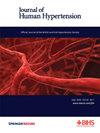Ambulatory blood pressure monitoring before and after resection of catecholamine-secreting pheochromocytoma or paraganglioma
IF 3.4
4区 医学
Q2 PERIPHERAL VASCULAR DISEASE
引用次数: 0
Abstract
Pheochromocytomas/paragangliomas are catecholamine-secreting tumors that are a rare cause of hypertension and associated with high cardiovascular risk. We aimed to evaluate changes in 24-h ambulatory blood pressure (BP) monitoring (ABPM) following tumor resection. Individuals with evidence of pheochromocytoma/paraganglioma prospectively underwent 24-h ABPM and plasma and urine catecholamine measurement 2–3 weeks before and 6–8 weeks after pathologically-confirmed tumor resection. Patients with metastatic disease were excluded. Changes in office, 24-h, daytime, and nighttime mean systolic and diastolic BP and heart rate, 24-h BP and heart rate average real variability, and rates of controlled, sustained, white coat, and masked hypertension were assessed in paired analyses. There were 34 participants who completed 24-h ABPM before and after tumor resection. Mean age was 55 ± 13 years, with 21 (62%) women, median duration of hypertension of 3 years, and 6 (18%) participants with coronary artery disease. Serum and urine catecholamines normalized following tumor resection and participants were prescribed 1 ± 0.2 fewer antihypertensive medications. Office BP declined by a mean 10 ± 16/7 ± 9 mmHg, 24-h BP declined by 8 ± 14/4 ± 10 mmHg, with greater improvement in nighttime (9 ± 18/5 ± 13 mmHg) than daytime (7 ± 14/4 ± 9) ambulatory BP. Systolic BP variability and heart rate variability significantly improved. While the frequency of controlled hypertension increased (4 [12%] to 11 [32%]; p = 0.008), there was no significant change in masked hypertension (9 [26%] to 12 [35%]; p = 0.366). In conclusion, pheochromocytoma/paraganglioma resection was associated with improvement in 24-h BP and BP variability, particularly nighttime BP. ABPM may be useful following tumor resection to identify patients with unrecognized residual cardiovascular risk.

儿茶酚胺分泌嗜铬细胞瘤或副神经节瘤切除术前后动态血压监测。
嗜铬细胞瘤/副神经节瘤是一种分泌儿茶酚胺的肿瘤,是一种罕见的高血压病因,并与高心血管风险相关。我们旨在评估肿瘤切除后24小时动态血压(BP)监测(ABPM)的变化。有嗜铬细胞瘤/副神经节瘤证据的个体在病理证实的肿瘤切除术前2-3周和术后6-8周,前瞻性地进行24小时ABPM和血浆和尿液儿茶酚胺测定。排除有转移性疾病的患者。在办公室、24小时、白天和夜间的平均收缩压和舒张压和心率的变化,24小时血压和心率的平均真实变异性,以及控制、持续、白大褂和隐蔽性高血压的发生率进行配对分析。34名参与者在肿瘤切除前后完成了24小时ABPM。平均年龄为55±13岁,其中21人(62%)为女性,中位高血压病程为3年,6人(18%)患有冠状动脉疾病。肿瘤切除后血清和尿儿茶酚胺恢复正常,降压药减少1±0.2。办公室血压平均下降10±16/7±9 mmHg, 24小时血压下降8±14/4±10 mmHg,夜间(9±18/5±13 mmHg)比白天(7±14/4±9)的改善更大。收缩压变异性和心率变异性明显改善。而控制高血压的发生频率从4例[12%]增加到11例[32%];P = 0.008),隐匿性高血压无显著变化(9例[26%]~ 12例[35%];p = 0.366)。总之,嗜铬细胞瘤/副神经节瘤切除与24小时血压和血压变异性的改善有关,特别是夜间血压。肿瘤切除后,ABPM可能有助于识别未识别的残留心血管风险患者。
本文章由计算机程序翻译,如有差异,请以英文原文为准。
求助全文
约1分钟内获得全文
求助全文
来源期刊

Journal of Human Hypertension
医学-外周血管病
CiteScore
5.20
自引率
3.70%
发文量
126
审稿时长
6-12 weeks
期刊介绍:
Journal of Human Hypertension is published monthly and is of interest to health care professionals who deal with hypertension (specialists, internists, primary care physicians) and public health workers. We believe that our patients benefit from robust scientific data that are based on well conducted clinical trials. We also believe that basic sciences are the foundations on which we build our knowledge of clinical conditions and their management. Towards this end, although we are primarily a clinical based journal, we also welcome suitable basic sciences studies that promote our understanding of human hypertension.
The journal aims to perform the dual role of increasing knowledge in the field of high blood pressure as well as improving the standard of care of patients. The editors will consider for publication all suitable papers dealing directly or indirectly with clinical aspects of hypertension, including but not limited to epidemiology, pathophysiology, therapeutics and basic sciences involving human subjects or tissues. We also consider papers from all specialties such as ophthalmology, cardiology, nephrology, obstetrics and stroke medicine that deal with the various aspects of hypertension and its complications.
 求助内容:
求助内容: 应助结果提醒方式:
应助结果提醒方式:


